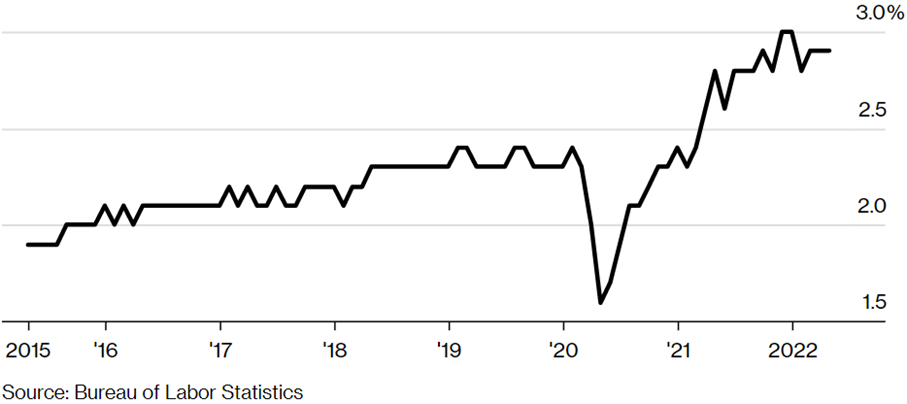The COVID-19 pandemic shut down businesses, disrupted lives, and resulted in millions of untimely deaths. Its impact to our supply chain and economy will continue to be felt for a long time, and unfortunately it also resulted in further challenges to industries that rely heavily on employees that cannot work from home. That is especially true for the printing and mailing industry.
As our nation continues to recover from COVID shutdowns, a trend has been emerging known as the Great Resignation. Employees who became accustomed to working from home or reflecting on lifestyle changes have been quitting their jobs at a continued record pace. This is despite fears of recession, stock market turbulence, or 40-year high inflation.
According to the Bureau of Labor Statistics, 4.4 million Americans quit their jobs in April alone. That is among the highest levels since 2000, and this trend shows no sign of slowing down. According to a survey by human resources firm Mercer, one-third of American workers surveyed said they were planning to quit their job in the next six to 12 months.

Mailers or mail service providers (MSP) who rely heavily upon employees in the workplace to operate software, services, and equipment to prepare and induct time-sensitive mailings are especially vulnerable to the impact of the Great Resignation. Many MSPs have already begun to explore ways to attract, retain, or, in some cases, replace manual processes in mail preparation with automated workflows. In some cases, this can even repurpose employees into positions of future growth or attract new employees to the mailing industry by updating open job descriptions with a more accurate reflection of today’s complex mail preparation processes.
We recently had one medium-sized MSP that was challenged with filling an open position to operate their USPS CASS and PAVE certified solution. The daily mail volume was about 225,000 pieces prepared by 142 employees. They were challenged with not only filing this key position, but also had issues growing their business as there never seemed to be enough time in the day to get everything prepared and out the door, due, in part, to complex mail preparation rules and frequent price changes. Each day, they processed 12 mailings, and each one took about 60 minutes to prepare.
By analyzing their workflow, they were able to upgrade the technology to leverage scripted processing and watch folder technology, which resulted in reducing their operating time from 60 minutes down to 20 minutes per job. This resulted in saving eight hours or processing time per day, which eliminated the need for the new position. And the cost of the software upgrade was less than half of what the annual salary would have been for the new employee.
Another MSP that was seeking an automated workflow to improve productivity opted to use technology with a visual graphic workflow tool. By visualizing how the name and address data would flow through the address correction, sortation, and labeling process, the operator could better understand the interoperability of the underlying mail preparation tools. This workflow upgrade not only allowed them to more quickly implement complex mailing workflows, but also resulted in attracting an employee from a competing MSP as the employee viewed the data visualization tool as a way to “level up” their career with data analytics.
While upgraded workflows can be one way to mitigate the Great Resignation by repurposing or retaining employees, sometimes simply upgrading an open position description can help to attract employees to an industry that may seem technologically dated for those that are unfamiliar with printing and mailing. Rather than looking for a mailroom operator to run CASS-Certified software, consider instead seeking a data analyst with an emphasis on advanced name and address parsing, matching, and cleansing. Or, given the complexity of presorting, perhaps the revised description is more akin to advanced logistics planning and analysis.
And do not be afraid to tout the fact that the mailing industry continually works with “big data” in some big and exciting ways. The USPS delivers over 100 billion pieces of mail to over 160 million delivery points every year. And every year, the United States adds over 1.1 million new delivery points to this vast and complex network. With over 6,500 families, businesses, and individuals moving every hour, the mailing industry network is anything but static!
Finally, make sure to include career growth as part of the overall recruitment package when trying to mitigate the Great Resignation. Employees want to see ways to “level up” their careers, and the Mail Piece Design Professional certification is an excellent way to invest in employees while simultaneously increasing the value of your services as an MSP to your customers. And do not forget to also check out your local Postal Customer Council for additional educational opportunities and to share best practices in attracting and retaining employees for your automated workflows.
Chris Lien is EVP Postal Affairs for BCC Software, a BlueCrest Company.
This article originally appeared in the September/October, 2022 issue of Mailing Systems Technology.










